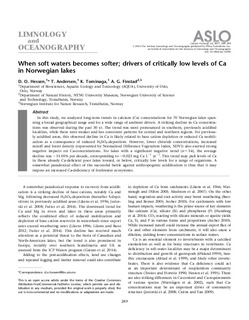| dc.contributor.author | Hessen, Dag Olav | |
| dc.contributor.author | Andersen, Tom | |
| dc.contributor.author | Tominaga, Koji | |
| dc.contributor.author | Finstad, Anders Gravbrøt | |
| dc.date.accessioned | 2018-01-31T09:16:59Z | |
| dc.date.available | 2018-01-31T09:16:59Z | |
| dc.date.created | 2017-05-05T19:10:58Z | |
| dc.date.issued | 2017 | |
| dc.identifier.citation | Limnology and Oceanography. 2017, 62 (1), 289-298. | nb_NO |
| dc.identifier.issn | 0024-3590 | |
| dc.identifier.uri | http://hdl.handle.net/11250/2480863 | |
| dc.description.abstract | In this study, we analyzed long-term trends in calcium (Ca) concentrations for 70 Norwegian lakes spanning a broad geographical range and for a wide range of ambient drivers. A striking decline in Ca concentrations was observed during the past 30 yr. The trend was most pronounced in southern, previously acidified localities, while there were weaker and less consistent patterns for central and northern regions. For previously acidified areas, this observed decline in Ca is likely related to base cation depletion or reduced Ca mobilization as a consequence of reduced H2SO4-deposition. However, lower chloride concentrations, increased runoff and forest density (represented by Normalized Difference Vegetation Index, NDVI) also exerted strong negative impacts on Ca-concentrations. For lakes with a significant negative trend (n = 34), the average decline was −11.05% per decade, corresponding to −0.023 mg Ca L−1 yr−1. This trend may pull levels of Ca in these already Ca-deficient poor lakes toward, or below, critically low levels for a range of organisms. A somewhat paradoxical effect of the successful battle against anthropogenic acidification is thus that it may impose an increased Ca-deficiency of freshwater ecosystems. | nb_NO |
| dc.language.iso | eng | nb_NO |
| dc.publisher | Wiley | nb_NO |
| dc.rights | Attribution-NonCommercial-NoDerivatives 4.0 Internasjonal | * |
| dc.rights.uri | http://creativecommons.org/licenses/by-nc-nd/4.0/deed.no | * |
| dc.title | When soft waters becomes softer; drivers of critically low levels of Ca in Norwegian lakes | nb_NO |
| dc.type | Journal article | nb_NO |
| dc.type | Peer reviewed | nb_NO |
| dc.description.version | publishedVersion | nb_NO |
| dc.source.pagenumber | 289-298 | nb_NO |
| dc.source.volume | 62 | nb_NO |
| dc.source.journal | Limnology and Oceanography | nb_NO |
| dc.source.issue | 1 | nb_NO |
| dc.identifier.doi | 10.1002/lno.10394 | |
| dc.identifier.cristin | 1468528 | |
| dc.description.localcode | © 2016 The Authors Limnology and Oceanography published by Wiley Periodicals, Inc. on behalf of Association for the Sciences of Limnology and Oceanography This is an open access article under the terms of the Creative Commons Attribution-NonCommercial-NoDerivs License | nb_NO |
| cristin.unitcode | 194,31,10,0 | |
| cristin.unitname | Institutt for naturhistorie | |
| cristin.ispublished | true | |
| cristin.fulltext | preprint | |
| cristin.qualitycode | 1 | |

